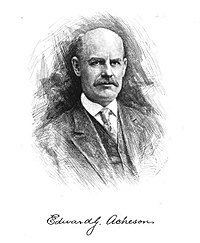Nationality American Name Edward Acheson | Role Chemist Known for Silicon carbide | |
 | ||
Born March 9, 1856Washington, Pennsylvania, USA ( 1856-03-09 ) Books A Pathfinder: Inventor, Scientist, Industrialist Notable awards Franklin Institute, Perkin Medal Similar People Thomas Edison, Henri Moissan, Nikola Tesla, Andrew Mellon, George Westinghouse | ||
Moment in history extra who was edward goodrich acheson
Edward Goodrich Acheson (March 9, 1856 – July 6, 1931) was an American chemist. Born in Washington, Pennsylvania, he was the inventor of the Acheson process, which is still used to make Silicon carbide (carborundum) and later a manufacturer of carborundum and graphite.
Contents
- Moment in history extra who was edward goodrich acheson
- Tetsuya Osaka ECS Edward Goodrich Acheson Award Lecture
- Biography
- Recognition
- References
Tetsuya Osaka - ECS Edward Goodrich Acheson Award Lecture
Biography
Acheson (1856–1931) was raised in the coal fields of southwestern Pennsylvania. Acheson attended the Bellefonte Academy for three years, 1870–72; this being the totality of his formal education. He left school at the age of 16 to help support his family after his father died, and worked as a surveying assistant for the Pittsburgh Southern Railroad.
He devoted his evenings to scientific pursuits—primarily electrical experiments. In 1880 he had the temerity to attempt to sell a battery of his own invention to Thomas Edison and wound up being hired. Edison put him to work on September 12, 1880 at his Menlo Park, New Jersey laboratory under John Kruesi. Acheson experimented on making a conducting carbon that Edison could use in his electric light bulbs.
After a year he was sent to Europe to install electrical lighting systems in the Hotel de Ville in Antwerp and La Scala in Milan, among other public places.
In 1884, Acheson left Edison and became supervisor at a plant competing to manufacture electric lamps. He began working on the development of methods to produce artificial diamond in an electric furnace. After heating a mixture of clay and coke in an iron bowl with a carbon arc light he found shiny, hexagonal crystals (silicon carbide) attached to the carbon electrode. He called it carborundum.
In 1891 Acheson built an electricity plant in Port Huron at the suggestion of Edison, and used the electricity to experiment with carborundum.
On February 28, 1893, he received a patent on this highly effective abrasive although a 1900 decision gave "priority broadly" to the Electric Smelting and Aluminum Company "for reducing ores and other substances by the incandescent method".
Acheson received 70 patents relating to abrasives, graphite products, reduction of oxides, and refractories. He was awarded the first Acheson Award, named in his honour, by the Electrochemical Society in 1931.
He died on July 6, 1931, in New York City.
Recognition
In 1953, the Pennsylvania Historical and Museum Commission installed a historical marker outside his home, noting the historic importance of his achievements. In 1997, Acheson was inducted into the National Inventors Hall of Fame. His house, the Edward G. Acheson House in Monongahela, Pennsylvania is a National Historic Landmark.
As one of The Electrochemical Society's most prestigious members, the organization presents an award in his name every two years to distinguish contributions to the advancement of any of the objects, purposes, or activities of the Society.
